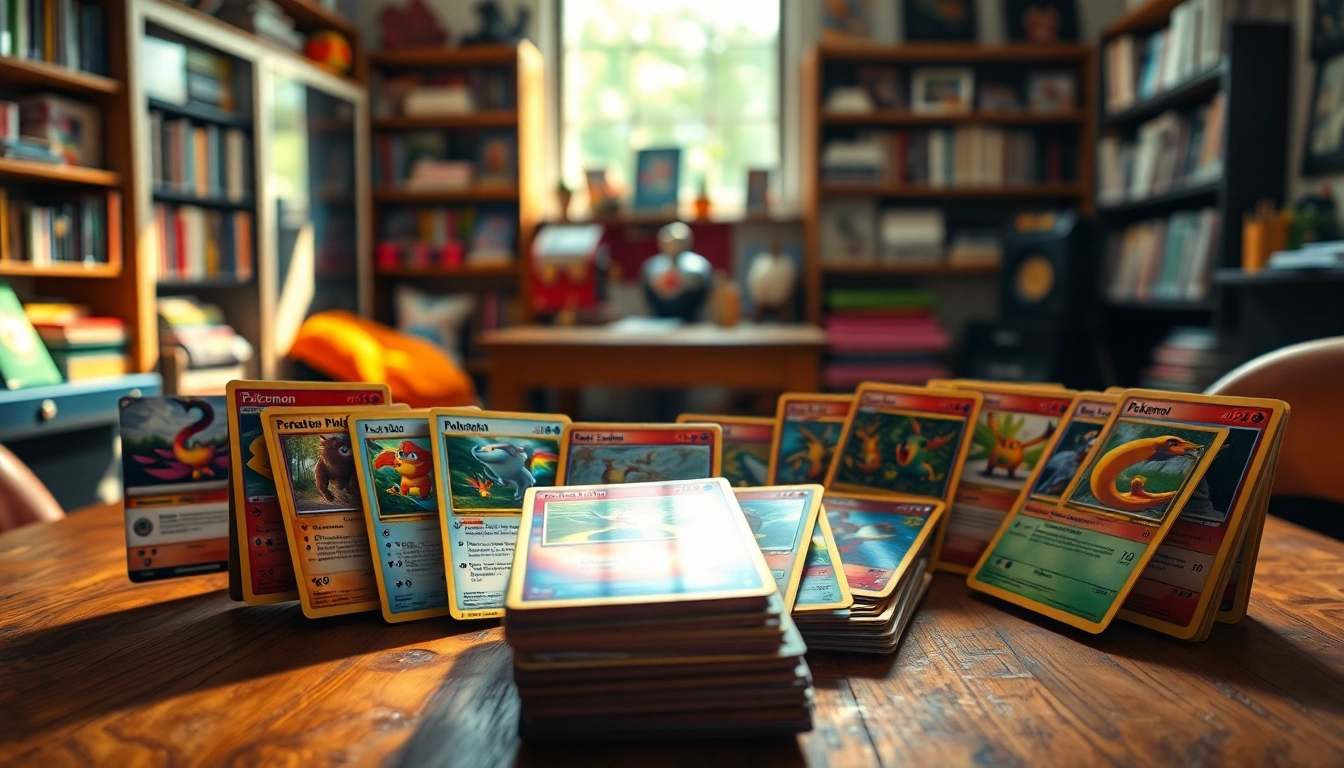Understanding Real Pokemon Cards
When diving into the fascinating world of Pokémon card collecting, one of the primary concerns for collectors, novices and veterans alike, is distinguishing real Pokemon cards from forgeries. Authentic Pokémon cards not only hold inherent value but also provide an avenue for nostalgic connections to the franchise that has thrived since its inception. This article will guide you through the essentials of understanding, identifying, and collecting genuine Pokémon cards while enhancing your overall collecting experience.
What Makes a Pokemon Card Genuine?
To appreciate the essence of a genuine Pokémon card, one must acknowledge the meticulous design and manufacturing process. Genuine Pokémon cards, like any high-quality collectible, are crafted to meet exact specifications.
- Material Quality: Authentic cards are made from a specific type of cardboard that feels sturdy and has a distinct texture. The printing of the artwork is vibrant and sharp.
- Official Holograms: Many rare cards feature holographic elements that are difficult to replicate. These add depth and a reflective quality, differentiating them from counterfeits.
- Font and Layout: Each authentic card has consistent font styles and layouts. Checking spelling and design particulars can be a quick way to rule out fakes.
Common Characteristics of Authentic Cards
Recognizing the characteristics of real Pokémon cards can prevent considerable disappointment. Here are key identifying features:
- Card Thickness: Genuine Pokémon cards maintain a specific thickness, providing a robust feel in hand.
- Backing Design: Authentic cards have a distinct backing design, with the iconic blue color and Pokéball logo.
- Green Mark Size: The green mark at the card’s bottom typically denotes the card’s rarity and should be proportionate and well-placed.
- Print Quality: Original cards boast high-quality prints, with colors that remain vibrant and artwork finely rendered, unlike the washed-out images of fakes.
The History of Pokemon Card Collecting
Pokémon card collecting began in 1996, capturing the hearts of enthusiasts across the globe. Initially introduced as part of the Pokémon Trading Card Game (TCG), these cards have evolved over the decades, often reflecting the trends and changes in the Pokémon universe.
As the franchise grew, so did the interest in its cards, culminating in a vibrant community of collectors and players. Events like the Pokémon World Championships and local tournaments give avid fans a reason to engage with others who share their love for Pokémon.
Identifying Fake Pokemon Cards
The market is flooded with counterfeit Pokémon cards that can easily mislead unwary collectors. A systematic approach to identifying fakes will prove beneficial.
Key Signs of Fake Cards
When attempting to identify a counterfeit Pokémon card, here are some warning signs to watch out for:
- Inconsistent Edges: Authentic cards have smooth and consistent edges, while fakes may exhibit rough or uneven cuts.
- Color Discrepancies: Fake cards often exhibit poor color quality and might appear too bright or dull compared to their authentic counterparts.
- Weight Variances: Authentic cards have a specific weight. If a card feels unusually light or heavy, it may not be genuine.
Common Myths About Pokemon Card Authenticity
Various myths surround the authenticity of Pokémon cards, which can perpetuate misleading notions among collectors:
- All Holographic Cards Are Rare: While many holographic cards have value, not all are rare. Some may still be easily obtainable.
- The Year of Production Determines Value: While the age of a card contributes, the rarity and condition play significant roles in value, making younger cards high in worth if rare.
- Online Vendors Are Always Trustworthy: Just because a card is listed online doesn’t guarantee its authenticity. Always vet vendors thoroughly.
Resources for Verification
As you dive deeper into the world of Pokémon cards, several resources can assist you in verifying authenticity:
- Online Forums: Platforms like Reddit and dedicated Pokémon communities provide real-time discussions on card authenticity.
- Professional Grading Services: Companies like PSA (Professional Sports Authenticator) and BGS (Beckett Grading Services) offer official grading of cards.
- Collector Guides: Reference books and websites can serve as valuable tools for understanding the nuances of Pokémon cards.
Buying Real Pokemon Cards
Acquiring real Pokémon cards can be an exhilarating experience but requires careful consideration to ensure authenticity.
Top Online Retailers for Genuine Cards
Several reputable online marketplaces offer access to authentic Pokémon cards. Below are some leading retailers:
- Pokémon Center: The official Pokémon website provides a wide selection of official TCG products, ensuring authenticity.
- TCGPlayer: This platform allows individual sellers to list cards, where buyers can browse prices and seller ratings.
- eBay: While eBay can be a treasure trove, it’s vital to check seller ratings and reviews to avoid fakes.
Comparing Prices Across Different Platforms
Price comparison is crucial when seeking genuine Pokémon cards. Here’s how you can approach it effectively:
- Utilize Price Tracking Tools: Websites like TCGPlayer offer real-time price tracking for various cards.
- Monitor Auctions: Sometimes, bidding can yield lower prices, but be prepared for last-minute bids that might push the price higher.
- Take Note of Shipping Costs: Sometimes a card’s price may be lower on one site, but higher shipping fees can offset savings.
Local Game Stores vs. Online Shops: Pros and Cons
When it comes to purchasing Pokémon cards, both local game stores and online shops have their unique advantages and challenges:
Local Game Stores
Pros:
- Ability to inspect cards physically.
- In-person community engagement and events.
- Expert advice from knowledgeable staff.
Cons:
- Limited inventory compared to online stores.
- Potentially higher prices for certain cards.
Online Shops
Pros:
- Wider selection and availability of rare cards.
- Convenience of shopping from home.
- Often competitive pricing due to marketplace structure.
Cons:
- No physical inspection before purchase.
- Shipping times and costs can vary.
Caring for Your Pokemon Card Collection
Successfully maintaining your Pokémon card collection is essential to preserving its value over time. Proper care and storage are vital.
Best Practices for Storing Cards
Storing your Pokémon cards correctly is paramount to ensuring they don’t deteriorate:
- Flat Storage: Always store cards flat to avoid bending and warping; never stack cards unless separated by protective materials.
- Controlled Environment: Store cards in a cool, dry place to avoid moisture and heat, which can damage them.
- Use Storage Boxes: Card storage solutions can help you keep your cards organized and protected from physical damage.
Protective Sleeves and Cases Explained
Utilizing protective sleeves and cases is an indispensable part of card collection maintenance. Here are the recommended types:
- Standard Sleeves: Ideal for everyday protection against wear and tear.
- Toploaders: Offer superior protection for valuable cards, serving as a rigid encasement.
- Binders: A great way to organize your cards while allowing for easy viewing.
Maintaining Card Value Over Time
To ensure your collection maintains its value, keep the following considerations in mind:
- Handle with Care: Always handle cards with clean hands, and avoid touching the surfaces.
- Regular Maintenance: Periodically check the condition of your cards and replace damaged protective gear as needed.
- Market Awareness: Stay informed about market trends which can positively or negatively affect card values.
Community and Trends in Pokemon Card Trading
The Pokémon card community is expansive and dynamic. Engaging with fellow collectors can enhance your experience and offer new opportunities.
Joining Local and Online Trading Groups
Connecting with like-minded individuals can greatly enhance your collecting journey:
- Social Media Groups: Platforms like Facebook and Discord host groups where collectors buy, sell, and trade.
- Local Meetups: Attending local gaming events or tournaments can expose you to potential trades and expert advice.
- Online Market Forums: Websites dedicated to card trading can provide a wealth of resources and options to acquire new cards.
Current Trends in Collecting Real Pokemon Cards
As with any collectible, trends evolve. Here’s what’s currently influencing the Pokémon card market:
- Revival of Vintage Cards: Nostalgia has led to a resurgence in interest for older card sets.
- Special Editions: Limited runs and expansions often become highly sought after, driving demand.
- Digital Collectibles: The rise of digital versions of Pokémon cards and NFT (Non-Fungible Tokens) has created new avenues for collection.
Participating in Pokemon TCG Events
One of the most engaging ways to immerse yourself in the Pokémon community is by participating in Trading Card Game (TCG) events:
- Local Tournaments: Community-driven tournaments often encourage participation and showcase card skills.
- International Championships: These offer significant prizes and recognition within the community and can be thrilling experiences for participants.
- Convention Appearances: Events such as Pokémon conventions often feature opportunities for trading, competitions, and even unique merchandise.
Conclusion
Understanding real Pokémon cards goes beyond mere collection; it’s about creating lasting connections with the franchise and forming a community. By applying the knowledge from this guide, you can enhance your collecting experience, distinguish authentic cards from fakes, and engage meaningfully with fellow collectors. Remember, as with any collecting hobby, there’s always something new to discover, so dive in and enjoy the adventure that is Pokémon card collecting!



